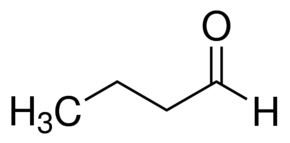Formula C4H8O Density 800 kg/m³ | Boiling point 74.8 °C Molar mass 72.11 g/mol | |
 | ||
Related aldehyde Related compounds | ||
Butyraldehyde, also known as butanal, is an organic compound with the formula CH3(CH2)2CHO. This compound is the aldehyde derivative of butane. It is a colourless flammable liquid with an acrid smell. It is miscible with most organic solvents.

Production
Butyraldehyde is produced almost exclusively by the hydroformylation of propylene:
CH3CH=CH2 + H2 + CO → CH3CH2CH2CHO
Traditionally, hydroformylation was catalyzed by cobalt carbonyl and later rhodium complexes of triphenylphosphine. The dominant technology involves the use of rhodium catalysts derived from the water-soluble ligand Tppts. An aqueous solution of the rhodium catalyst converts the propylene to the aldedyde, which forms a lighter immiscible phase. About 6 billion kilograms are produced annually by hydroformylation.
Butyraldehyde can be produced by the catalytic dehydrogenation of n-butanol. At one time, it was produced industrially by the catalytic hydrogenation of crotonaldehyde, which is derived from acetaldehyde.
Upon prolonged exposure to air, butyraldehyde oxidizes to form butyric acid.
